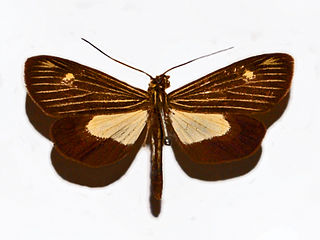Pikroprion is a genus of moths of the family Notodontidae. It consists of only one species, Pikroprion sullivani, which is endemic to the Choco habitat along the western slopes of the Andes in Ecuador and Colombia.
Erbessa albilinea is a moth of the family Notodontidae first described by James S. Miller in 2008. It is found in Costa Rica.

Erbessa cingulina is a moth of the family Notodontidae first described by Herbert Druce in 1885.
Erbessa lamasi is a moth of the family Notodontidae first described by James S. Miller in 2008. It is found in south-eastern Peru.
Polypoetes oteroi is a moth of the family Notodontidae. It is found in Venezuela.
Chrysoglossa norburyi is a moth of the family Notodontidae first described by James S. Miller in 2008. It is found in Costa Rica.
Nebulosa elicioi is a moth of the family Notodontidae first described by James S. Miller in 2008. It is endemic to the eastern slope of the Ecuadorian Andes.
Nebulosa sirenia is a moth of the family Notodontidae. It is found in Bolivia and south-eastern Peru.
Scoturopsis franclemonti is a moth of the family Notodontidae. It is found in the eastern Andes of southern Peru.
Xenomigia pinasi is a moth of the family Notodontidae. It is found along the eastern slope of the Ecuadorian Andes.
Pareuchontha olibra is a moth of the family Notodontidae. It is found along eastern slope of the Ecuadorian Andes.
Tithraustes snyderi is a moth of the family Notodontidae. It is found in cloud-forest habitats within La Amistad, an international park extending from south-central Costa Rica into the Chiriqui Province of Panama.
Azaxia hamula is a moth of the family Notodontidae. It is found in Colombia and north-eastern Ecuador.
Dicentria cymatila is a moth of the family Notodontidae. It is found in north-eastern Ecuador.
Disphragis anatole is a moth of the family Notodontidae. It is found in north-eastern Ecuador and possibly eastern Peru.

Disphragis notabilis is a moth of the family Notodontidae first described by William Schaus in 1906. It is found throughout the Amazon basin from western Venezuela east- and southward to at least Bolivia. The range includes French Guiana.
Malocampa confusa is a moth of the family Notodontidae. It is found in north-eastern Ecuador.
Urgedra janzeni is a moth of the family Notodontidae first described by James S. Miller and Paul Thiaucourt in 2011. It is found in north-eastern Ecuador.
Xenomigia caesura is a moth of the family Notodontidae. It is found in north-eastern Ecuador.
Xenomigia cosanga is a moth of the family Notodontidae. It is found in north-eastern Ecuador.

